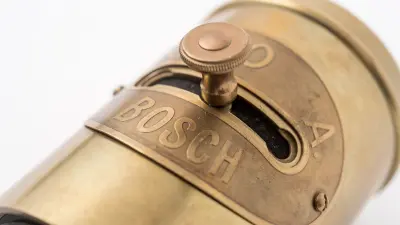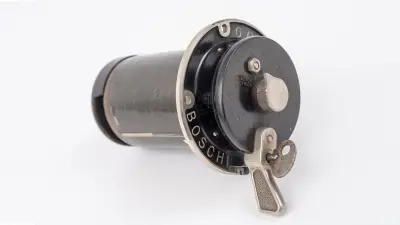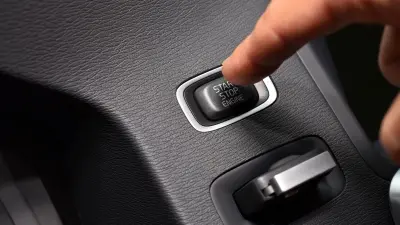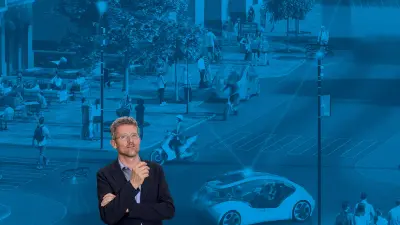The path from an analog to a digital car key
Farewell to a part of automotive history

No sad farewell: At the "Digital Kindergarten” technology and digital event in Hamburg, Bosch first ceremoniously buries the car key and then presents its successor, "Perfectly keyless”. An obituary with an optimistic outlook.

A warm June day in Hamburg. Expectancy and suspense are lying in the air. Thousands of people have gathered in the Millerntor Stadium to discover tomorrow’s trends at the “Digital Kindergarten” technology and digital event. But then suddenly a somber mood overcomes the stadium — the crowd looks over towards the player’s tunnel where a funeral procession is slowly approaching. It passes the rows of incredulous spectators to the main stand. The mourners are accompanied by a small band whose musicians are playing a sad tune. It is a classic jazz burial, not on a New Orleans boulevard but right in the middle of the Hanseatic city in the north of Germany.
“Let us bid farewell to an old friend,” is how a man dressed in a priest’s cassock begins the funeral eulogy. “Let us thank it for so any unforgettable moments over the 100 or so years.” An oversized key appears the moment the stretcher is uncovered, and it is now clear who Bosch is paying its last respects to.

Key moments in the last 100 years
The car key really does have a long history. Bosch has supplied ignition switches with the appropriate key ever since 1911. If it was not placed in the keyhole then the ignition could not be turned on and the engine did not start up. It was the first anti-theft protection for cars. The interior locking system first appeared in the 1920s. Prior to that most vehicles did not have a roof covering the whole passenger compartment so that there was no need for lockable doors.
For a long time, car owners had to carry several keys around with them — one for the door, one for the ignition and sometimes ones for the gas cap and the trunk. It was only in the 1960s that there was a single door and ignition key — the forefather of key system of today. When the central locking system became popular at the start of the 1990s, the key received a remote control which further increased locking comfort. However, here too the shape of the key has hardly changed. Now in the digital era, it gives the impression of being cumbersome and old hat.
Troublesome companion
In his funeral eulogy, the priest therefore speaks of the downsides of the car key. “You were never really smart. In fact, you were quite inflexible and broke most of the time at just the wrong moment.” Like at every funeral, memories come flooding back. Who has not got annoyed at leaving his or her car key behind when hurrying out of the house or at not finding it at all? How often did it get on our nerves when it showed its rough side by scratching away at the display of our mobile phones in pockets or bags. Some old models that cannot be folded away even pierced holes in pant pockets. And if the car key was lost, a replacement could prove to be expensive. No wonder that a survey conducted by the PULS market research institute on behalf of Bosch discovered that 76 percent of Germans found their car key a pain.

Digital car key
However, the end of the car key is a new beginning for Bosch: In the moment the ceremony in the Hamburg stadium reaches its emotional low point, a huge smartphone is revealed. To be seen on the display is the app-based Perfectly keyless system from Bosch. “The car key will be resurrected. Better, safer, cooler: #LikeABosch“, rejoices the priest and the mourners follow suit.
The digital key really does make life a lot simpler and easier: Car drivers can use it to automatically unlock, start and lock their vehicles even without having to take their smartphone to hand. It suffices to have it on one’s person. Such keyless entry systems have been around since the end of the 1990s. Up until now the car key has however transmitted a permanent signal that is recognized by the vehicle. It however bears risks: Car thieves can intercept the key’s signal and transmit it to the car with a range extender.

Perfectly keyless from Bosch relies instead on a mobile phone as the digital key and Bluetooth as the transmission technology. In doing so, microchips integrated in every smartphone communicate with the sensors built into the vehicle and a special control unit. It means the vehicle recognizes the mobile phone of the owner as securely as if it was a fingerprint and opens it only for him or her.
If the mobile’s battery is empty, users can still unlock the car using near-field communication (NFC), a wireless protocol for sharing data over short distances. Should the smartphone get lost, the system can also be deactivated. Handing over the key to other drivers is also quite easy: The smartphone-based app enables its users to activate family members, friends or colleagues for a vehicle, and to limit the time it can be accessed.
Perfectly keyless, the digital key for the car, literally opens the door to a better future and marks the end of a bothersome appendage for many people in their everyday lives. The role of the key will in future be performed by the smartphone, an item most people carry around with them all the time. People will therefore have no trouble in bidding farewell to the physical car key. For this reason, the mourners in the Millerntor Stadium transform themselves into a festival parade that winds its way out of the stadium not sadly but dancing joyously.








